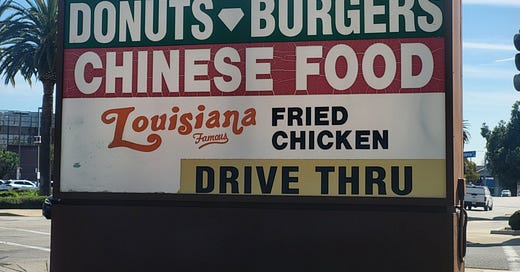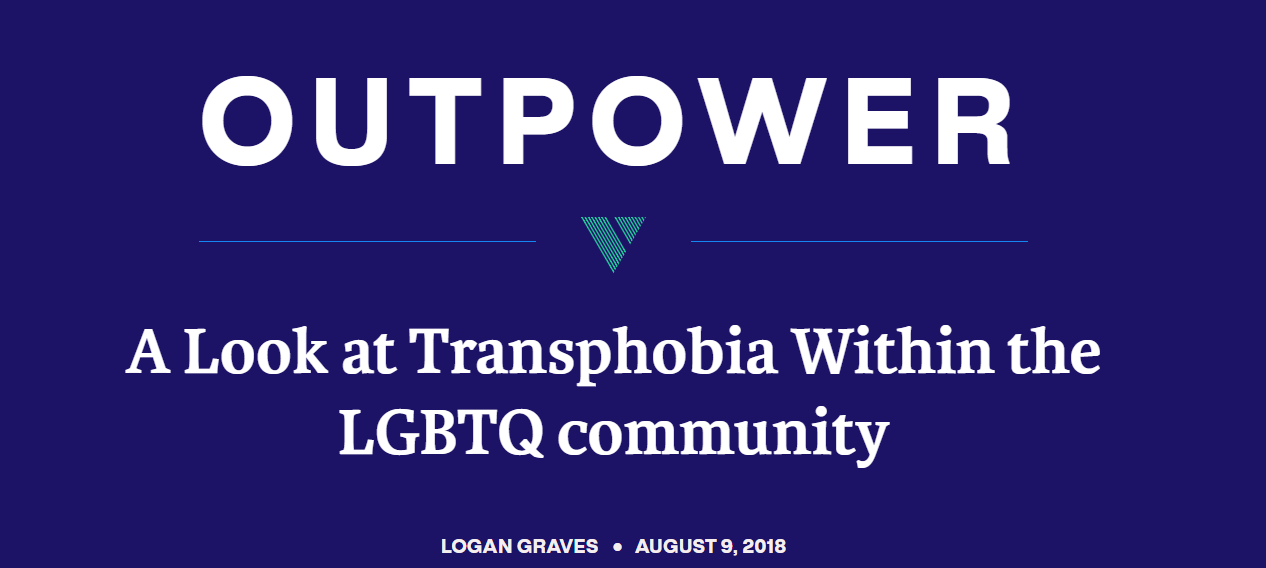Crossroads of Intersectionality
Is the Buffet of Sexual Identities, Preferences, and Fetishes closed?
What are you in the mood for?
Whatever you need, we got you.
Taco Trigger - what kinda taco you talkin?
THE ALPHABET WAR OF 2025
The fault lines have been drawn, and the once-unified LGBTQ+ movement is fracturing. The Stonehill Riots have ignited a cultural battle, with accusations flying in all directions. Are gay men and lesbians—the very people who once fought for equality—now being cast as the new oppressors? Has the movement erased its own trans and drag roots, or is this a case of shifting priorities and power struggles?
Lines are being redrawn, histories are being contested, and the future of queer identity itself is at stake. I’ve written about this subject before (post below) and have found the topic trending lately, especially here on Substack. Who belongs, who decides, and who gets left behind?
At Compass Star Wordsmith, we navigate the stormy seas of culture and politics, cutting through the noise to uncover the deeper currents shaping our world. If you value bold, nuanced perspectives, consider becoming a paid subscriber—or simply like and share to help keep these conversations going.
Let’s look at The Alphabet Wars of 2025—where identity, history, and ideology collide.
For decades, the LGBTQIA+ movement stood as a unified front against discrimination, drawing strength from its diverse voices and shared struggle. But as we enter 2025, the movement finds itself at a crossroads, torn between factions with competing visions of identity, inclusion, and historical narrative. The latest ideological battle—dubbed The Alphabet Wars—has pitted the LGB (lesbian, gay, and bisexual) community against the TQUIA+ (trans, queer, intersex, asexual, and beyond) activists, raising questions about the very nature of queer identity and progress. The piece below lays out the alphabetical apocalypse.
A Point of View: The Alphabet Soup of Gender and Sexuality
As if gender and sexuality weren’t complicated enough, the issues around them become even more complex when you consider all the diverse communities that have aligned themselves in what is often called the “alphabet soup” of the queer community. What was once called simply “gays and lesbians” morphed into “GLB” (for gay, lesbian, and bisexual) and soon after became “LGBT” (to include transgender people). The letters, along with the new identities they signify, just keep coming. Often, when I’m discussing gender and sexuality with a friendly audience, I’ll rattle off the acronym “2SLGBTQQIAA+” just to get a response … and will then proceed to break down the whole thing.
The Roots: Stonewall and the Foundation of the LGBTQ+ Movement
The Stonewall Riots of 1969 are often heralded as the birth of the modern LGBTQ+ rights movement. The popular narrative emphasizes the role of trans women of color, such as Marsha P. Johnson and Sylvia Rivera, in igniting the uprising. Yet, this framing has been challenged in recent years, with some scholars and activists arguing that Stonewall was a broader coalition of drag queens, butch lesbians, gay men, and street youth resisting police harassment.
As the 1970s unfolded, the movement found itself consolidating around specific goals—decriminalization of homosexuality, workplace protections, and an end to psychiatric classifications of same-sex attraction as a disorder. Transgender issues, while present, often took a backseat as mainstream gay and lesbian organizations prioritized broader civil rights battles.
The 1980s and the AIDS Crisis: A Unifying Tragedy
The AIDS epidemic of the 1980s brought a renewed sense of unity, as the community faced government neglect and widespread stigma. Organizations like ACT UP and the Gay Men’s Health Crisis (GMHC) mobilized to demand action, but trans representation within these movements remained limited. While transgender activists played a role in advocacy, the crisis disproportionately affected gay men, particularly white gay men, who became the movement’s public face.
1990s to 2010s: The Rise of Identity Politics and the Expanding Acronym
The 1990s and 2000s saw the LGBTQ+ movement gain significant legislative victories, from the repeal of Don’t Ask, Don’t Tell to the legalization of same-sex marriage. Yet, tensions simmered beneath the surface. As queer theory and intersectionality gained traction in academic and activist circles, a new generation of advocates sought to expand the movement’s focus beyond sexual orientation to include gender identity, race, and systemic power structures.
The acronym itself evolved—what was once LGB became LGBT, then LGBTQ, then LGBTQIA+, reflecting the push for greater inclusion. But with this expansion came new conflicts: whose voices should be prioritized? Were trans issues overshadowing the struggles of gay and lesbian individuals? Was the movement still fighting for the same goals?
The Modern Divide: LGB vs. TQUIA+
In 2025, these long-standing tensions have erupted into open conflict. The Stonehill Riots and other recent clashes have exposed deep divisions within the community. A significant rift has emerged between traditional LGB activists and the more radical gender activists who accuse them of transphobia and exclusionary behavior.
One flashpoint in this debate is the issue of dating preferences. Many lesbians and gay men have resisted the notion that refusing to date trans individuals—particularly trans women (biological males)—is inherently bigoted. This mirrors arguments once used against straight people who refused to date outside their sexual orientation. Critics argue that using accusations of transphobia in this context erodes the foundational principle of same-sex attraction, reducing sexuality to a matter of ideological compliance rather than personal autonomy.
Another source of contention is the role of drag queens and trans figures in historical narratives. Some activists claim that the modern trans movement has retroactively inserted itself into the history of Stonewall and early LGBTQ+ activism, minimizing the contributions of gay men and lesbians. Others counter that the erasure of trans voices is a form of historical revisionism designed to fit a more palatable, assimilationist narrative.
Where Does the Movement Go from Here?
As these ideological battles rage on, the future of LGBTQIA+ advocacy remains uncertain. Will the movement split into separate factions, each pursuing its own goals? Can a balance be struck between respecting diverse identities while maintaining the integrity of same-sex attraction as a legitimate category?
The crossroads have been reached. Which path will the movement take? It’s important to know origin and backstories, so the links below are good info.
Rising Popularity of Transgender Pornography
The intersection of public consumption of transgender pornography and the ongoing debates within the LGBTQIA+ community presents a complex dynamic. The increasing popularity of such content raises questions about societal perceptions, objectification, and the internal discourse on identity and inclusion.
Recent data indicates a significant surge in the consumption of transgender-themed adult content. In 2022, Pornhub reported a 75% increase in the popularity of its "transgender" category, making it the 7th most popular category worldwide and the 3rd most popular in the U.S.
In 2022, porn under the “transgender” category increased in popularity by 75% to become the 7th most popular category worldwide and the 3rd most popular in the U.S., according to the tube site’s report. In addition, “FTM” searches were eight times more popular than “MTF” searches. And men viewed videos tagged as “trans” 22% more than women. However, women on “straight” Pornhub viewed the “trans male” sub-category 115% more than men, lest we think that being a chaser is only limited to one gender or sexuality. Pornhub even noted that the most searched-for gender identities were “non binary,” “gender x” (whatever that means) and “androgynous.”
This trend suggests a growing public interest in transgender individuals within a sexual context.
Impact on Public Perception
While increased visibility can lead to greater awareness, the context of this exposure is crucial. Transgender pornography often portrays trans individuals through a fetishized and objectified lens, which can perpetuate misconceptions and reinforce harmful stereotypes. Such depictions may influence viewers' attitudes, leading them to view transgender people primarily as sexual objects rather than as whole individuals with diverse experiences and identities, says tandfonline.com
Internal Community Controversies
Within the LGBTQIA+ community, the consumption of transgender pornography intersects with debates on transphobia, misinformation, and personal boundaries. Some gay men and lesbians face criticism for expressing discomfort or unwillingness to engage in romantic or sexual relationships with transgender individuals, with accusations of transphobia being levied against them. This discourse mirrors arguments historically used against heterosexual individuals who were labeled as bigoted for not considering same-sex relationships.
The prevalence of transgender pornography adds another layer to this controversy. While the content is consumed widely, often by heterosexual men, it does not necessarily translate to acceptance or understanding of transgender identities. Instead, it can lead to a fetishization that dehumanizes trans individuals, reducing them to mere objects of sexual desire. This objectification can exacerbate divisions within the community, as it conflicts with the push for genuine inclusivity and respect for personal autonomy in romantic and sexual preferences.
Ivana Fischer is the Culture Editor of WUSSY and a film and media enthusiast who specializes in cultural studies. You can find her across all socials @iv.fischer
This is a loaded topic, but one on the leading edge of politics and culture. I look forward to hearing from readers about your thoughts. Your ideas are the gas in this word engine.
Ric














Colors and creeds united by metabolic syndrome, diabetes, and 40” waists.
God love America!
All I see is people who are so wrapped up in their sexuality, they have no identity outside of who they choose to sleep with.